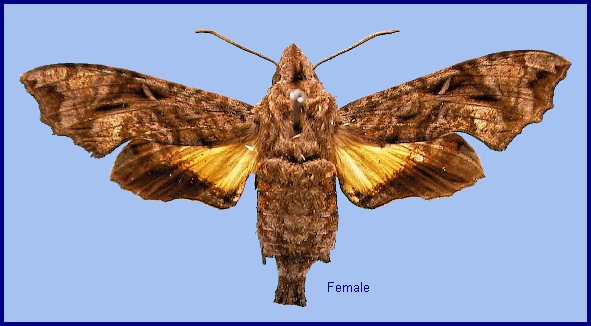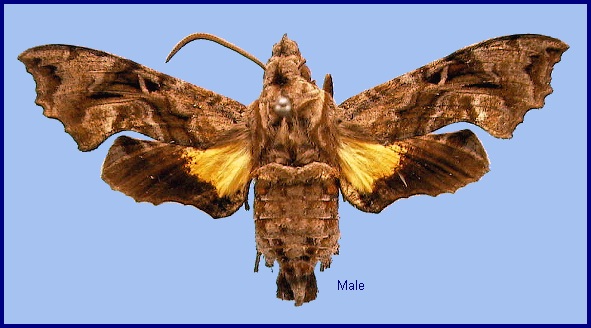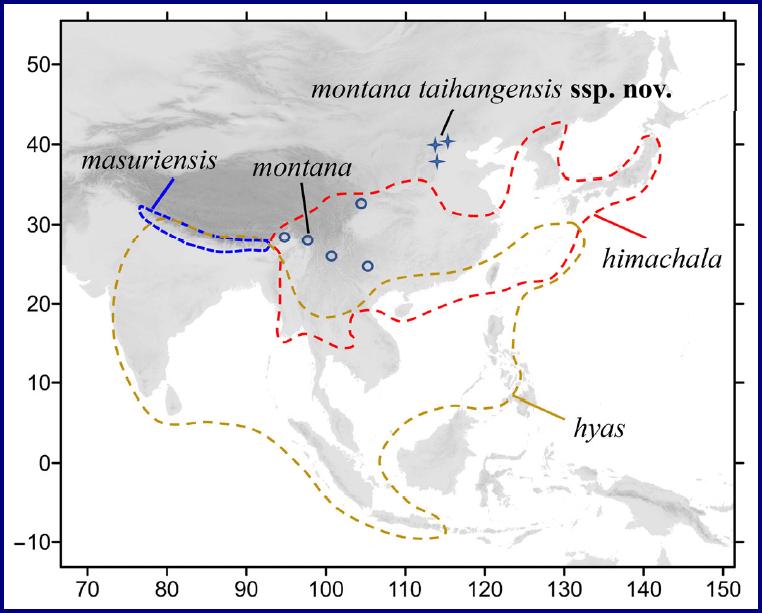

Lophura masuriensis Butler, 1875, Proc. zool. Soc. Lond. 1875: 244. Type locality: Masuri [Mussorie, Uttarakhand, India]
Synonym. Lophura masuriensis Butler, 1875.
Wingspan: 42--50mm. Greyer than Neogurelca himachala (Butler, [1876]); anal lobe of forewing shorter, the hind margin not quite so deeply excised as in Neogurelca himachala; black border of hindwing narrowing behind, not sharply defined on inner side, diffused on to disc; the yellow area paler, particularly on underside.
In the male genitalia, anal tergite more compressed than in Neogurelca himachala, sternite less broad and more gradually narrowed to a point. Harpe spatulate, concave on upperside, apical margin incised or emarginate above middle, proximally of the apical dilated portion a low obliquely transverse ridge. The apical armature of phallus consists of a prominent non-dentate ridge which ends at both sides with a sharp hook pointing frontad (Bell & Scott, 1937).
According to Bell & Scott (1937), larvae of this species are fairly common in India during the rainy season at about 6000' altitude.
OVUM: Pale yellowish-green (Bell & Scott, 1937).
LARVA: Full-fed 50mm, width 8mm, horn 5mm. According to Bell & Scott (1937), in the first instar horn short, straight, bifid, a long bristle on each point. Long simple hairs on head, bifid hairs on segments 2 and 3 and trifid hairs on remaining segments, short simple hairs on horn. Head and body at first very pale yellowish-green with a broad pale brown dorsal stripe and a broken pale brown lateral stripe. After twenty-four hours head pale green; dorsum of body dark green dotted with white; rest of body pale green; a whitish subdorsal stripe; horn black, all the hairs black. In the second instar, hairs on body very short; head green; body bluish-green dotted with white. There is a pale brown dorsal stripe and a whitish subdorsal stripe from segment 2 to base of horn. Very pale brown oblique lateral stripes are visible; the horn is black; spiracles black ringed with white. In the third instar, horn of medium length; oblique lateral stripes white; horn black with base purple. In the fourth instar, head green dotted with paler green, with a yellowish stripe-separating face from cheek. Dorsum of body dark green, lateral area paler green. There is an encircling row of small white tubercles around each division of each segment; a broad white subdorsal stripe from segment 2 to base of horn; and seven whitish oblique lateral stripes. Horn straight, of medium length, basal half purple, distal half white with a black tip, the whole covered with black tubercles. Spiracles black. In some individuals there are irregular purplish-brown spots above the oblique lateral stripes.
In the fifth and instar, horn of medium length, thick at base, tapering abruptly to a sharp point, straight or curved slightly upwards and held nearly vertical. Surface dull and smooth except for the horn, which is covered with small tubercles. Colour variable. In the green form head dark green dotted with white; a yellowish stripe, edged sometimes with pale brown, separates face from cheek. Body pale green in dorsal area, bright apple-green in lateral area, with a transverse row of pale yellow dots around each secondary ring. There is a whitish, sharply defined subdorsal stripe on segments 2 to 6, and seven sharply defined, white oblique lateral stripes, that on 5 narrower than the rest, all edged above with irregular-shaped brown patches variable in size. There are irregular markings of dark brown on dorsum. Basal half of horn brown above, reddish below, distal half dirty yellow with black tip, the tubercles black. True legs pale red; prolegs, claspers and venter brown. Spiracles black, the dumbbell-shaped central slit white (Bell & Scott, 1937).
In the dark-coloured form the whole of the green areas are brown, and there are other forms intermediate between the green and the dark-coloured forms.
PUPA: 25mm, width 8mm. Head, thorax and wing-case very pale ochreous, dorsum spotted with dark brown, the lateral and ventral surfaces closely, transversely barred with dark brown. Abdomen ochreous, with a broad black transverse band on the hind edge of each segment encircling the body. There are also broken dark brown transverse bars in the dorsal area turning to dots in the lateral and ventral areas. Spiracles and cremaster black. Latter elongate-conical, ending in a simply pointed shaft (Bell & Scott, 1937).
Larval hostplants. Leptodermis lanceolata [syn. Hamiltonia fruticosa] (Rubiaceae) in India (Bell & Scott, 1937).
China: Southern fringe of Xizang/Tibet.
From northwestern India westwards along the southern Himalaya of northern India into Bhutan (Irungbam & Irungbam, 2019), and north just into southern Xizang/Tibet, China (Xu ZhenBang, pers. comm. 2025). A record of this species from Yunnan, China, is erroneous; the specimen was confused with Neogurelca himachala.

Map: Distribution of species of genus Neogurelca in Asia. The ranges of three species are represented by dashed lines. The blue circles indicate the populations of N. montana montana in Yunnan and Sichuan, the blue stars indicate the populations of N. montana taihangensis in Beijing and Hebei (© Xu, He, Yang, Kitching & Hu, 2023).
 Return to Sphingidae of the Eastern Palaearctic species list
Return to Sphingidae of the Eastern Palaearctic species list